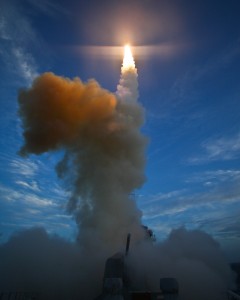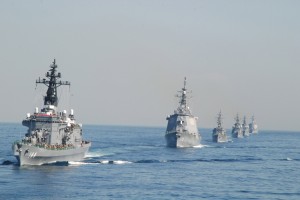2012-09-30 By Richard Weitz
During the Cold War, the core bargain was that the United States would defend Japan against external attack while the Japanese government would contribute to its immediate self-defense and offer generous financial and other support, including hosting U.S. military facilities on Japanese territory.
American strategists consider Japan the anchor of U.S. strategy in East Asia because of Japan’s strategic location, status as an economic superpower, sophisticated self-defense capabilities, and willingness to host a large military presence in the region.
Following the end of the Cold War, both Tokyo and Washington sought to restructure their bilateral alliance to respond to 21st-century challenges.
For example, the U.S.-Japan Joint Declaration of 1996 stated that the United States and Japan would collaborate to address “situations that may emerge in the areas surrounding Japan and which will have an important influence on the peace and security of Japan…[and] the Asia-Pacific region.”
In 1997, Tokyo and Washington revised the 1978 “Guidelines for U.S.-Japan Defense Cooperation” to specify that Japan would provide “rear area support” for U.S. forces conducting overseas military operations in certain East Asian military contingencies that could have a direct impact on Japanese security. (Interestingly, Prime Minister Obuchi Keizo in 1999 explicitly stated that the “areas surrounding Japan” did not include the Indian Ocean and Middle East.)
In 1999, Japan enacted legislation, the Regional Contingencies Law, which allows the government to conduct joint operational planning with the United States for contingencies that occurred outside its national territory “in situations in areas surrounding Japan that will have an important influence on Japan’s peace and security.” The Bush administration then continued to strengthen the U.S.-Japanese alliance based on the foundation laid in the Clinton administration by Joseph Nye, former Assistant Secretary of Defense for International Security Affairs.

Since 2005, the main institutional framework for Japanese-U.S. interaction on bilateral security issues has been the Security Consultative Committee (SCC), which involves regular meetings of the two countries’ senior defense and foreign policy officials (informally known as the “2+2”meeting since 2007). SCC meetings have produced joint statements articulating their common strategic objectives, establishing new roles and missions for their defense forces, and announcing revisions in the U.S. military bases and deployments in Japan.
For example, its working groups have devoted much attention to develop and implement plans to transfer U.S. military forces from Okinawa to Guam, integrate U.S. and Japanese military headquarters and training facilities in Japan (including at Camp Zama and Yokota Air Base), and improve bilateral cooperation in fulfilling 16 specific mission areas (such as air defense, critical infrastructure protection, and human relief operations).
The triple crisis caused by Japan’s March 2011 earthquake, tsunami, and nuclear emergency has thus far had three main effects on Japan’s national security policies.
First, the crisis has focused the attention of Japanese security managers’ inward toward domestic humanitarian assistance and disaster relief operations.
Second, it has reinforced the Japanese-U.S. alliance, which was already growing stronger due to the Japanese government’s decision to abandon earlier efforts to seek a more independent security policy due to perceptions of increased external threats from the East Asian mainland.
Third, U.S. military assistance for the Japanese recovery effort helped reduce popular animosity to the American military presence in Japan.
Japanese-U.S. security relations stalemated for several years after the DJP assumed power in 2009 and publicly pledged to relocate the Futenma Air Base “outside of the prefecture.” It was not until the dispute was finally resolved that a DJP prime minister was able to make an official visit to the White House in April 2012.
The Japan-U.S. Joint Statement during Yoshita Noda’s trip affirmed the harmony of the two countries regional security and economic goals based on liberal democratic principles. Indeed, the Obama administration’s strategic rebalancing to Asia and the DJP’s commitment to developing a dynamic defense force can profitably reinforce on another by facilitating their shared goal of promoting peace and stability throughout East Asia through an elevated security presence and measures to maintain access to the global commons such as freedom of navigation and secure cyber networks.
The common strategic objectives included several related to China, such as promoting defense transparency and adherence to widely accepted international norms of behavior, discouraging the acquisition of destabilizing military technology, promoting multinational security cooperation, and ensuring access to global commons of the sea, air, space, and cyberspace.
The Joint Statement also called for bilateral measure to strengthen U.S. extended deterrence guarantees, increase joint training and exercises, and expand information sharing and joint intelligence, surveillance, and reconnaissance (ISR) activities, and deepen cooperation regarding humanitarian missions as well as space and cyber space security.

Tokyo’s new approach has specific implications for bilateral defense cooperation with the United States, with its emphasis on joint and shared use of facilities, joint training and exercises, and joint ISR activities.
Japan has already increased security cooperation with regional allies and expanded the range of permissible arms exports.
The June 21, 2011 meeting of the Japan-U.S. Security Consultative Committee meeting issued a list of the “common strategic objectives” of the two countries in the final Joint Statement, “Toward a Deeper and Broader US-Japan Alliance: Building on 50 Years of Partnership.” It somewhat widened the goals enumerated in the February 2005 and May 2007 “2+2” meetings as well as recommitted the two governments to their 2006 Joint Roadmap for Realignment Implementation.
Some of the common strategic objectives included a focus on China.
Among such objectives are the following:
Promoting defense transparency and adherence to widely accepted international norms of behavior, discouraging the acquisition of destabilizing military technology, promoting multinational security cooperation, and ensuring access to global commons of the sea, air, space, and cyberspace.
The Joint Statement also called for bilateral measure to strengthen U.S. extended deterrence guarantees, increase joint training and exercises, and expand information sharing and joint intelligence, surveillance, and reconnaissance (ISR) activities, and deepen cooperation regarding humanitarian missions as well as space and cyber space security.
The 2010 NDPG also identifies cooperation with other partners and broader multinational security cooperation (such as participation in UN peacekeeping operations) as well as Japan’s own efforts as essential for achieving an effective deterrent. Australia, South Korea, and especially the United States were identified as key allies due to their shared values and interests. Several new trilateral initiatives have been launched in recent years involving Japan, the United States, and another partner.
Progress has been greatest with Australia, with the launching of joint foreign and defense ministerial (“2+2”) meetings in 2007 and the signing of a 2010 Acquisition and Cross-Servicing Agreement.
Despite shared concerns about North Korea, Japan’s bilateral and trilateral cooperation involving South Korea has made less progress due to historical tensions and other differences. The United States has sought to facilitate this cooperation but has limited leverage in this regard.
Furthermore, the Japanese government led by the DPJ, which had originally sought stronger ties with these threatening countries in order to reduce their security dependence on Washington, is now trying to bolster its military alliance with the United States. These close ties were in evidence in June 2010, when U.S. Secretary of State Hillary Clinton and Secretary of Defense Robert Gates hosted Japanese Foreign Minister Takeaki Matsumoto and Defense Minister Toshimi Kitazawa in Washington for the Japan-U.S. Security Consultative Committee (SCC) meeting.
This session represented the first SCC meeting under the new governments in both Tokyo or Washington. The ministers released a comprehensive joint statement highlighting their common strategic objectives and policies to achieve them within the framework of a stronger U.S.-Japan alliance.
Japan is also considering participating in the U.S.-backed Trans-Pacific Partnership (TPP), which has emerged as the Obama administration’s core multilateral economic initiative for the Asia Pacific region and the model for future U.S.-supported free trade agreements throughout the world. It would address issues beyond those covered by the World Trade Organization (WTO) or other existing free-trade agreements (FTA), providing greater protection for intellectual property and lowering non-tariff barriers to trade as well as reducing more traditional tariffs.
Although the TPP is symbolic of renewed U.S. economic leadership in East Asia, its global economic impact will remain small unless Japan joins. But powerful interest groups in both countries, especially rice producers in Japan and auto manufactures in the United States, oppose the initiative.
Seen from another perspective, the evolution of the U.S.-Japanese strategic relationship is evolving from that Cold War synthesis to one embracing the reality of new conditions.
As mentioned above, the Cold War synthesis included a Japanese focus on a very narrow interpretation of the defense of Japanese territory. Such a focus no longer makes sense given the nature of North Korean capabilities and the robust activities of the PRC in Asia and beyond.
This shift has been captured by the notion of “dynamic defense.” Notably, the Japanese recognized the need for these “dynamic defense” forces to be interoperable with allies to provide for the kind of defense Japan and the allies needed in light of changing dynamics in the region. The United States-Japanese relationship is being recrafted to enable the “dynamic defense” of Japan and new strategy in the Pacific.
https://sldinfo.com/dynamic-defense-and-the-japanese-defense-white-paper-2012/

